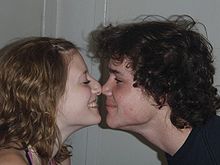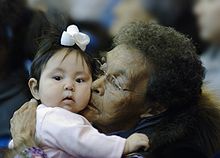Eskimo kiss
This article needs additional citations for verification. (May 2008) |


In modern Western culture, an eskimo kiss is the act of pressing the tip of one's nose against another's. It is loosely based on a traditional Inuit greeting called a kunik.[1]
A kunik is a form of expressing affection, usually between family members and loved ones, that involves pressing the nose and upper lip against the skin (commonly the cheeks or forehead) and breathing in, causing the loved one's skin or hair to be suctioned against the nose and upper lip.[2] A common misconception is that the practice arose so that Inuit could kiss without their mouths freezing together. In fact, it is a non-erotic form of greeting that serves as an intimate way of greeting one another for people who, when they meet, often have little except their nose and eyes exposed.
When early explorers of the Arctic first witnessed this behavior they dubbed it Eskimo kissing. In its western form it consists of two people rubbing noses together. One of the earliest representations of the Eskimo kiss comes from Robert Flaherty's 1922 film Nanook of the North, considered by many to be the first real documentary or ethnographic film. It is possibly from this source that the non-Inuit/Eskimo public became aware of this convention.
Similar traits are shown in greetings of other people, notably the hongi and honi greeting used by the Māori of New Zealand and Hawaiians respectively, and by Mongolian nomads of the Gobi desert, as well as certain Southeast Asian cultures such as Bengalis, Cambodians, Laotians, Thai, and Ibans.[citation needed] Nose rubbing, rather than touching, is employed by traditional Yemini tribesmen.
Scenes involving Eskimo kissing are included in countless media, including episodes of The Simpsons, South Park and in a Chappelle's Show sketch in which Eskimo kissing is portrayed as a stereotypically white gesture.
See also
References
- ^ Elder, Jeff (2005-02-16). "An 'Eskimo kiss' is a kunik, and maybe not what you think". South Coast Today. Retrieved 2008-01-09.
- ^ "Eskimo Kisses, Arm Hair, Moon Flags & Spike Lee vs. Stan Lee vs. Bruce Lee". Esquire Magazine. 2007-05-09. Retrieved 2008-01-09.
